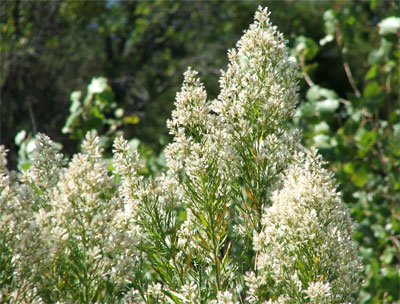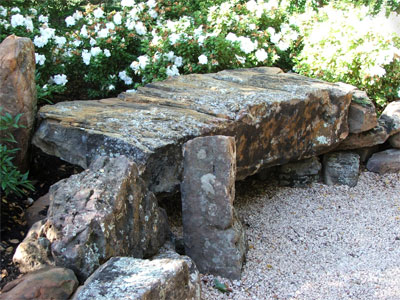Native Son – October, 2008

The creamy inflorescences of Baccharis neglecta.
Photo by Steven Chamblee.
Stones and Bones and Baccharis
You know, life’s adventure isn’t really about where you take your body; it’s about where you take your mind. Road trips can be grand and glorious ventures that span hundreds or thousands of miles, but if your mind never discards the chaff of your daily existence to taste the sweet seed of life, you really haven’t gone anywhere. Conversely, sometimes a little jaunt down the road for an everyday errand can bring us to a new awareness — such as it was for me yesterday, during a little trip to the stone yard.
I slid out the Chandor Gardens gate and took the longer, yet faster, route to the stone yard. The goal was simple — acquisition of a stone boulder to install as a bench at the Chandor Labyrinth, preferably one that could be muscled into place by me, Toby, and our friend, Rock Bar. The morning air was cool, and from a rise in the road I could see out across some meadows that will soon, sadly but surely, be bulldozed to accommodate the hunger of that monster I call Urban Sprawl.
But today I chose to simply enjoy the view. As my eyes feasted on small patches of goldenrod, gayfeather, assorted sunflowers, and billowing heath asters (there was also a single, way-out-of-season specimen of Indian paintbrush, but that’s another story), my eyes fell upon those huge, puffy clouds of the native shrub called Baccharis. Baccharis became embedded in my soul back in the fall of 1991, as I drove down Highway 377 from Fort Worth to Stephenville four days a week to attend classes at Tarleton State University. I had left steady employment to return to school full time, and reveled in every minute of it, including that beautiful daily drive through the countryside. Baccharis was new to me then, and my curiosity to learn about it took me down several proverbial dusty roads, where I met amazing people and learned things about myself that had largely gone unnoticed until I “bloomed” in college.
This 6- to 10-foot-tall shrub also goes largely unnoticed, except when it blooms into a huge froth of fuzzy, cream-colored inflorescences during autumn. Baccharis is dioecious, a term that means the male and female flowers are found on separate plants. (Conversely, monoecious plants have both flowers on the same plant.) There are two dominant species of Baccharis in North Texas, the most common being Baccharis neglecta; the larger B. haminifolia maxes out around 16 feet tall. These plants go by a number of other common names: B. neglecta is often called Roosevelt weed, New Deal weed, or Jara Dulce; B. haminifolia goes by sea-myrtle, consumption weed, and groundseltree. The Roosevelt and New Deal names refer to it being planted in post-Dust Bowl days to revegetate barren fields. As far as the “consumption” thing, I really don’t know, but it may be from when someone confused autumn allergies with tuberculosis. I also had several nicknames during those college days, my favorite of which was “Yellowbear,” but that’s another story….
So I pull into the stone yard and begin the quest for the perfect stone. Simple enough you would think … it has to weigh 700 pounds or less, make a good seating bench, and blend harmoniously into the site. Hmmm … I never really considered a cut slab, but that one’s a beauty. Wow … the giant chunks of limestone could just be laid right on the ground, with no need for legs or support. Nah, they are too white … but the aged ones back there are nicely hued. Geesh, check out the Texas Red! Cut on two sides, with dished texture on the remaining sides that looks like the fluted marks on an arrowhead. I gotta have that! That’s the one. For sure. Positive. Hmmm, I haven’t even looked at the other side of the yard yet. I suppose I ought to go check that out before I decide.
Wow! Look at these babies! That one has perfect texture … color’s good … a little big … probably 1200 pounds. Maybe we could borrow the tractor to help…. Now where did they get that one? It even has moss and lichens and cacti on it. That’s got to be it! Whoa … what’s that one over there? Geez, get a load of the one behind it … wow, wow, wowwwww, look at that one three rows down … no, the one back by the fence … wait, just past the giant beach pebbles … is that one hiding from me under the live oak tree? Where do all of these things come from? Milsap … Austin … Texas … Pennsylvania … Arkansas … Mississippi … Arizona … New Mexico … Old Mexico … Rocky Mountains… Smoky Mountains… AHHHH!!!
My brain was spinning like a carnival Tilt-a-Whirl, so I decided to take a break and talk it over with Juan, one of the guys who work there. I have visited him many times before, and he always gets me just what I’m looking for … even if it is on the back row and he has to move many pallets to get it. The man is amazing with the loader, and I’ll bet he could sew a button on your shirt and mix martinis with the same machine he uses to move 6,000-pound rocks. He also maintains an even keel all the time, even when the yard is swarming with demanding customers. Today, it is just me, so I figure if I can tap into that unflappable, mellow mentality, I can make a sound decision.
“Juan, I just can’t seem to decide on which is the perfect stone. Can you help me?”
He smiles softly and broadly, and rubs his bristled chin with his work-hardened fingers, which seem to have become stone-like themselves. “I have been watching you. You have looked at every stone here. Still … you cannot decide.”
“I know, I feel awful about it. It’s crazy … there are so many choices, so many patterns and colors and textures. I know this is terrible to say, but I feel like a lady shopping for shoes.”
Juan laughs, almost giggles, which is a little out of character for him. He leans forward a bit, as if to keep his words confidential, which is a little strange, since there is not a soul within 200 feet of us. He whispers, “It may be worse than that.”
“Good heavens, man, what are you talking about?”
“Sometimes choosing the right stone,” he says, “is like choosing the right woman. Some are brightly colored, some are plain. Some are fancy, some are simple. Some smooth, others rough. They come from all over the world. But you must choose. If you do not choose, your stone will soon be taken by another man. In the end, you must choose a stone that makes you happy inside, makes you feel good when you see it, for it will be with you a long time.” He puts his fingertips together, closes his eyes, bows his head a little, and utters, “Sometimes the stone is still with you long after the woman is gone.”
I stood stunned at the metaphorical insight and depth of wisdom that had fallen from the lips of this man who had never set foot in a university. Suddenly, Juan cracks a grin and we both burst into laughter. He slaps me on the shoulder and we walk back to the two stones I had been agonizing over. I point confidently and say, “That’s the one.”
“Are you sure?” asked Juan with a sly smile and that special kind of impish glint in his eye that you can usually find only in Antonio Banderas movies.
I stand straight and announce stoically, “I can live with this one forever.”
Back at Chandor Gardens, the little tractor groaned while lifting the 1362-pound stone out of the truck. Three other guys from Parks showed up and we all set the new bench in place. After the straps were removed and the debris cleared away, we stood back to check it out. I thought it fit perfectly into the Labyrinth area, and Toby commented how it looked as if it had been there for 60 years … which is good, because we’re married to it now.

The mossy sandstone boulder, now at home at Chandor Gardens.
Photo by Steven Chamblee.
About the author: Steven Chamblee is the chief horticulturist for Chandor Gardens in Weatherford and a regular contributor to Neil Sperry’s GARDENS magazine and e-gardens newsletter. He adds this invitation to e-gardens readers:
Come see Chandor Gardens this fall! The new Labyrinth is completed and ready for you to enjoy, including that new stone bench! From Oct. 25 to Nov. 16, we’ll have a great collection of scarecrows around the garden. This a perfect time for family and children’s photos, so plan on bringing the whole gang out to Chandor Gardens.
Mark your calendar for Dec. 14, Chandor Gardens Open House. The house will be lavishly decorated for the holidays, and we will have music and refreshments. Best of all, it’s free!
Just take I-20 west to exit 409, hang a right, go 2.1 miles and hang a left on Lee Avenue. Head straight twelve blocks and you’re driving in the gates.
Our “for sure” open hours are Saturdays from 9 a.m. to 3 p.m. and Sundays from 1 p.m. to 5 p.m. For weekday visits, give us a call at 817-361-1700 or 817-598-4029 to let us know you’re coming. You can always go to www.chandorgardens.com for a picture tour and more information.

